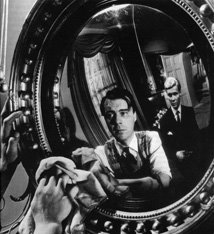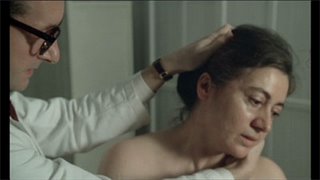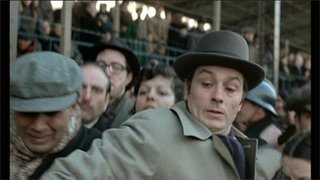For up to date information on all Trauma Film Screenings, don't forget to check out www.traumafilm.com


 When Mrs Esmond returns home from an abortive trip to Paris something is wrong. The scene is played out in real time. She enters through the door and reads a note awaiting her. The mirror reflects the out-of-field behind her. She is being watched. Something makes her uncomfortable and she turns. A young man is in her house, watching her. He is a guest of her husband. She climbs the staircase. Cut.
When Mrs Esmond returns home from an abortive trip to Paris something is wrong. The scene is played out in real time. She enters through the door and reads a note awaiting her. The mirror reflects the out-of-field behind her. She is being watched. Something makes her uncomfortable and she turns. A young man is in her house, watching her. He is a guest of her husband. She climbs the staircase. Cut.
Joseph Losey takes the juvenile delinquent movie, twists in some film noir, psychoanalysis, class consciousness, modernism and gives us The Sleeping Tiger. But who is the sleeping tiger? Is it Frank, the kid from a broken home. Mrs Esmond - Glenda - the frustrated wife of Dr Esmond. Or Dr Esmond, a psychoanalyst out to prove himself god... or is it all of them, in their own way?
This 1954 film is the first film Joseph Losey made in Britain after his his exile from America due to him being blacklisted as a communist - which he was. The subpoena went to his old address and he hightailed it to Europe. Working under the name of Victor Hanbury he directed this odd genre flick of mirrors and staircases... it is essential viewing from the director that went on to work with Pinter and Stoppard, to direct The Servant and Accident and become one the finest directors Britain - and Europe - has ever had.


 After seeing Harold Pinter's The Caretaker, Joseph Losey wrote to him saying how much he had liked it. Pinter replied with thanks, and asked for work... Thus was born the working relationship which would lead to three collaborations, The Servant (1963), Accident (1967) and The Go-between (1970).
After seeing Harold Pinter's The Caretaker, Joseph Losey wrote to him saying how much he had liked it. Pinter replied with thanks, and asked for work... Thus was born the working relationship which would lead to three collaborations, The Servant (1963), Accident (1967) and The Go-between (1970).
The Servant begins by playing out the master and servant power relationship between Dirk Bogard (as manservant Hugo) and James Fox (as pseudo-aristo Mr Tony) and is taken from the Robin Maugham novel of the same name. Pinter inflects the dialogue with his trademark repetitions, terse dialogue and menacing undertones. But the film belongs to Losey with his visual and sonic style maturing into an exceptional exploration of confined space: mirrors, staircases, shadows, long takes, strange angles, dripping taps, chiming clocks and intruding exterior soundscapes...
The film was lauded by critics and the public alike... and theorists have tended to focus upon the seeming reversal of the roles of Hugo and Tony as the film progresses. However, there is no simple reversal but rather an endless tug of war back and forth between Hugo, Tony and the women in their lives, Vera and Susan... this film then, rather than a manifesto for class war or socialist/communist ethics, explores power itself and in this way seems to sit more within the framework of Michel Foucault than Marx and Engels.


This film opens with an incredibly disturbing scene: a woman is undergoing a medical examination… standing and naked in a vast room with a nurse to take notes, a ‘doctor’ measures her facial features in order to determine her status: real French or Jew… this open scene sets the tone of the film, though the narrative is far more complex than would first seem…

1942, France. The country is divided into the Nazi occupied North and the Vichy controlled South. The Nazi racial policy is implemented in both. Mr Klein is a Catholic art dealer, making money out of Jews fleeing the regime.
Then ANOTHER Mr Klein – a Jew and a communist – deliberately confuses the machinery that is Nazi France as to the identity of the first Mr Klien… a cat and mouse games ensues… all the familiar Losey traits are here: mirrors, staircases, and shadows… and these elements fuse effortlessly with the narrative to forge a film marrying form and content to explore the ambiguity of identity: personal, national, racial… the mirrors reflect the actual status of the two Mr Kliens: they look the same, people confuse them… nothing is what it seems and the camera work reminds one of Se7en.

This, the final film in the Losey triptych, reminds one of Hitchcock’s North by Northwest… however, it is far darker. It is also one of Losey's more political films… an investigation of France’s complicity during the dark years of WW2… an incredible piece of work from 1976 and the beginning of Losey’s final phase of movie making, leaving the UK behind and working in France.



 When Mrs Esmond returns home from an abortive trip to Paris something is wrong. The scene is played out in real time. She enters through the door and reads a note awaiting her. The mirror reflects the out-of-field behind her. She is being watched. Something makes her uncomfortable and she turns. A young man is in her house, watching her. He is a guest of her husband. She climbs the staircase. Cut.
When Mrs Esmond returns home from an abortive trip to Paris something is wrong. The scene is played out in real time. She enters through the door and reads a note awaiting her. The mirror reflects the out-of-field behind her. She is being watched. Something makes her uncomfortable and she turns. A young man is in her house, watching her. He is a guest of her husband. She climbs the staircase. Cut.Joseph Losey takes the juvenile delinquent movie, twists in some film noir, psychoanalysis, class consciousness, modernism and gives us The Sleeping Tiger. But who is the sleeping tiger? Is it Frank, the kid from a broken home. Mrs Esmond - Glenda - the frustrated wife of Dr Esmond. Or Dr Esmond, a psychoanalyst out to prove himself god... or is it all of them, in their own way?
This 1954 film is the first film Joseph Losey made in Britain after his his exile from America due to him being blacklisted as a communist - which he was. The subpoena went to his old address and he hightailed it to Europe. Working under the name of Victor Hanbury he directed this odd genre flick of mirrors and staircases... it is essential viewing from the director that went on to work with Pinter and Stoppard, to direct The Servant and Accident and become one the finest directors Britain - and Europe - has ever had.


 After seeing Harold Pinter's The Caretaker, Joseph Losey wrote to him saying how much he had liked it. Pinter replied with thanks, and asked for work... Thus was born the working relationship which would lead to three collaborations, The Servant (1963), Accident (1967) and The Go-between (1970).
After seeing Harold Pinter's The Caretaker, Joseph Losey wrote to him saying how much he had liked it. Pinter replied with thanks, and asked for work... Thus was born the working relationship which would lead to three collaborations, The Servant (1963), Accident (1967) and The Go-between (1970).The Servant begins by playing out the master and servant power relationship between Dirk Bogard (as manservant Hugo) and James Fox (as pseudo-aristo Mr Tony) and is taken from the Robin Maugham novel of the same name. Pinter inflects the dialogue with his trademark repetitions, terse dialogue and menacing undertones. But the film belongs to Losey with his visual and sonic style maturing into an exceptional exploration of confined space: mirrors, staircases, shadows, long takes, strange angles, dripping taps, chiming clocks and intruding exterior soundscapes...
The film was lauded by critics and the public alike... and theorists have tended to focus upon the seeming reversal of the roles of Hugo and Tony as the film progresses. However, there is no simple reversal but rather an endless tug of war back and forth between Hugo, Tony and the women in their lives, Vera and Susan... this film then, rather than a manifesto for class war or socialist/communist ethics, explores power itself and in this way seems to sit more within the framework of Michel Foucault than Marx and Engels.


This film opens with an incredibly disturbing scene: a woman is undergoing a medical examination… standing and naked in a vast room with a nurse to take notes, a ‘doctor’ measures her facial features in order to determine her status: real French or Jew… this open scene sets the tone of the film, though the narrative is far more complex than would first seem…

1942, France. The country is divided into the Nazi occupied North and the Vichy controlled South. The Nazi racial policy is implemented in both. Mr Klein is a Catholic art dealer, making money out of Jews fleeing the regime.
Then ANOTHER Mr Klein – a Jew and a communist – deliberately confuses the machinery that is Nazi France as to the identity of the first Mr Klien… a cat and mouse games ensues… all the familiar Losey traits are here: mirrors, staircases, and shadows… and these elements fuse effortlessly with the narrative to forge a film marrying form and content to explore the ambiguity of identity: personal, national, racial… the mirrors reflect the actual status of the two Mr Kliens: they look the same, people confuse them… nothing is what it seems and the camera work reminds one of Se7en.

This, the final film in the Losey triptych, reminds one of Hitchcock’s North by Northwest… however, it is far darker. It is also one of Losey's more political films… an investigation of France’s complicity during the dark years of WW2… an incredible piece of work from 1976 and the beginning of Losey’s final phase of movie making, leaving the UK behind and working in France.




0 Comments:
<< Home